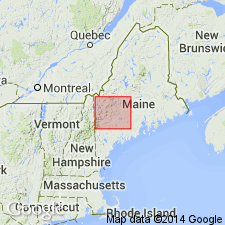
- Usage in publication:
-
- Dixville Formation
- Modifications:
-
- Not used
- AAPG geologic province:
-
- New England province
Summary:
Rocks previously assigned to the Dixville Formation by Harwood (1973) are here called unnamed black metashale because correlation with type Dixville of Green (1964) is uncertain. [Dixville not abandoned in this report.]
Source: GNU records (USGS DDS-6; Reston GNULEX).

- Usage in publication:
-
- Dixville Formation
- Modifications:
-
- Not used
- AAPG geologic province:
-
- New England province
Summary:
All rocks previously mapped as Dixville (or its Dixie Brook, Clear Stream, and Rice Mountain Members) in northern NH and adjacent ME by Hatch (1963), Green (1964, 1968), Green and Guidotti (1968), and Harwood (1973) are here reassigned to one or more different units in this quad. Green (1964) demonstrated that schist and quartzite of Dixie Brook Member conformably overlie schist and quartzite of Albee Formation; graded beds found at contact support this. During post-1978 mapping, it was recognized that this sequence was quite similar to Silurian Perry Mountain and Smalls Falls Formations of central ME trough; later mapping in Piermont-Frontenac allochthon further supported this similarity. Therefore, within limits of Piermont-Frontenac allochthon on this map, rocks previously assigned to Dixie Brook Member of Dixville by Green (1964) are now assigned to Smalls Falls Formation and rocks previously assigned to Albee Formation by Green (1964) are now assigned to Perry Mountain Formation. Rocks of Rice Mountain syncline previously assigned to Clear Stream and Rice Mountain Members by Green (1964) are now assigned to Smalls Falls Formation. Rice Mountain contains rocks typical of Smalls Falls; Clear Stream contains rocks typical of unnamed felsic volcanic lenses and basalt lenses within Smalls Falls. Although a U-Pb zircon age of 434 Ma (Silurian) was obtained from felsic volcanic lens of former Clear Stream rocks (Aleinikoff and Moench, 1985), date is considered 10 to 20 my too old for Smalls Falls, probably because of complicated isotopic systematics resulting from inheritance from Proterozoic source. In Second Connecticut Lake quad, rocks previously mapped as northern belt of Dixie Brook Member by Green (1968) are here reassigned to Hurricane Mountain Formation based on revised stratigraphic positions and lithologic similarity. Further north, rocks assigned to Magalloway Member of Dixville Formation by Green (1968) and Harwood (1973) now are thought to be largely resedimented facies of dacite and basalt members of Jim Pond Formation; because Magalloway rocks are distinctive, member is reassigned to Jim Pond Formation.
Source: GNU records (USGS DDS-6; Reston GNULEX).
For more information, please contact Nancy Stamm, Geologic Names Committee Secretary.
Asterisk (*) indicates published by U.S. Geological Survey authors.
"No current usage" (†) implies that a name has been abandoned or has fallen into disuse. Former usage and, if known, replacement name given in parentheses ( ).
Slash (/) indicates name conflicts with nomenclatural guidelines (CSN, 1933; ACSN, 1961, 1970; NACSN, 1983, 2005, 2021). May be explained within brackets ([ ]).

